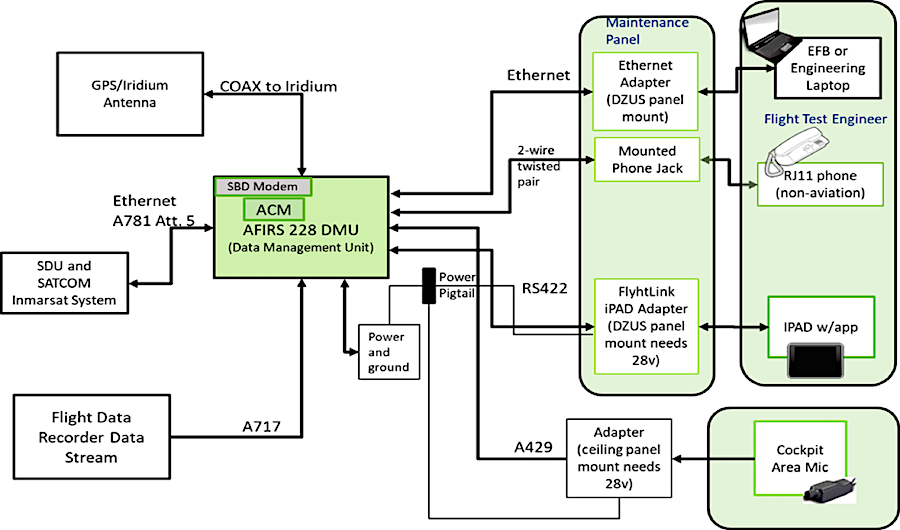
A diagram showing the embedded aircraft networking setup that was used by FLYHT to evaluate its’ Automated Flight Information Reporting System’s ability to enable minute by minute autonomous distress tracking under ICAO’s 2021 GADSS requirement.
Editorial Note: This article provides an overview of several aircraft hardware and software technologies that have demonstrated the ability to enable minute-by-minute distress tracking in accordance with ICAO’s 2021 GADSS Annex 6 changes. For a more in-depth look at new regulations and some of the technologies airlines are embracing, check out the full version of this article in the April 2019 edition of Avionics International.
Airlines are already adopting new technologies to meet the International Civil Aviation Organization’s (ICAO) 2021 autonomous distress tracking requirement. In some cases, modification of aircraft electronics or operating software is required. In other cases, an update to the way their web-based flight data monitoring technology of choice triggers automatic streams of distress data off an aircraft are all that’s needed.
All aircraft with type certification later than Jan. 1, 2021, weighing more than 60,000 pounds and capable of transporting more than nineteen passengers must feature the ability to autonomously transmit aircraft position reports minute-by-minute when flying with conditions considered to be life-threatening to passengers and flight crews onboard.
This concept is known as autonomous distress tracking (ADT). It becomes applicable in 2021 under changes related to the Global Aeronautical Distress Safety System (GADSS) that the International Civil Aviation Organization (ICAO) first adopted to its Annex 6 aircraft operating standards and recommended practices in 2016.
While the ADT requirement becomes applicable to Annex 6 in 2021, civil aviation regulators are adopting that ICAO airworthiness standard as individually interpreted mandates. Avionics suppliers already have the capabilities to meet the requirement today.
Texas-based Sabre, for example, provides flight following and aircraft data management software that enables minute-by-minute autonomous distress tracking with no avionics upgrades required.
Sabre’s ACARS Manager is an aircraft communications management software that can interface with every and all aircraft data link service provider networks, including those using satcom and very high-frequency radio on oceanic or polar routes. The position reports generated through this software are displayed to an operator on a Gantt chart and a moving map display depicting the flight path of the aircraft.
The company is meeting the autonomous distress tracking requirement by analyzing the ACARS messaging set coming off of the aircraft.
“We’ve found it’s possible to determine whether an aircraft has had an electrical failure or an engine is out of parameters or another distress condition based off the ACARS messaging data that’s coming down from the aircraft,” said Richard Landeck, global supervisor of Sabre’s airline solutions division.
Elsewhere, some avionics makers have already proven their ability to meet minute-by-minute tracking requirements in flight technology demonstration projects, a list that includes Canadian manufacturer and aircraft data streaming service provider FLYHT.
The company demonstrated this capability during the 2018 Boeing ecoDemonstrator program, where a FedEx 777 was equipped with its Automated Flight Information Reporting System (AFIRS) satellite communications computer. The AFIRS system uses a proprietary software known as the embedded launching application to determine what information an airline wants to capture about its aircraft’s performance.
That application also compresses the collected data before it is transmitted across Iridium’s satellite system and down to the company’s cloud-based Uptime server, where the file is unzipped and distributed to an airline’s maintenance or flight operations department in an actionable format.
“The ARINC 717 data, the same data that goes to the FDR, is going to the AFIRS unit,” said Kent Jacobs, director of advanced applications for FLYHT.

FLYHT’s Automated Flight Information Reporting System (AFIRS) data management unit comes with a web-based interface that airlines can use to drag and drop and trigger automated minute-by-minute position reporting of an aircraft under distress. Shown above is the company’s interface for the system. Photo: FLYHT
Some of the automatically triggered conditions that were set for the trial included unusual attitude, a bank angle above 30 degrees or a pitch exceeding 15 degrees lasting more than 2 seconds. If the AFIRS system detected any of the pre-defined conditions occurring throughout the flight, it would autonomously trigger a streaming session of 1,024 words per second using Inmarsat’s Swiftbroadband satellite network.
During the ecoDemonstrator trial, the AFIRS unit was configured with both an internal inertial navigation system to detect when pitch, attitude or ground speeds should be triggered, streamed and monitored. Jacobs said they also used the system to stream cockpit audio in real time.
Another approach to enabling ADT operations is provided through a new breed of emergency locator transmitter (ELT) technology.

Orolia’s ELT distress tracking concept of operations. Photo: Orolia
Paris, France-based aircraft ELT manufacturer Orolia is leading the deployment of this technology and is in the final stages of certification for its new “Ultima” distress tracking ELTs for Air France’s fleet of Airbus A320s.
Their new ELT system is lithium ion battery-powered with an internal antenna capable of transmitting 406 and 121.5 MHz signals. The antenna also has embedded global navigation satellite system reception and Orolia also provides a separate ADT module that gets installed within the aircraft’s cockpit control panel.
When the ADT module captures a distress signal or condition and transmits it to the ELT, a a distress message can be remitted to air traffic controllers, search and rescue agencies and the aircraft operator’s ground-based personnel. The module’s signaling of a distress condition then also triggers minute-by-minute tracking.
In the event of an aircraft experiencing a power failure, the new ELT still transmits distress signals to the COSPAS SARSAT satellite system, which has provided free search and rescue satellite emergency locator service to the aviation industry for more than two decades.
“The idea is to have the distress trigger occur in-flight before the aircraft crashes,” said Christian Belleux, director of Orolia’s aviation and military product lines. “The previous generation of ELTs were activated by G forces at the impact of the crash.”